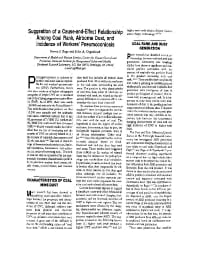Mining Publication: Suggestion of a Cause-and-Effect Relationship Among Coal Rank, Airborne Dust, and Incidence of Workers' Pneumoconiosis
Original creation date: November 2000
Authors: SJ Page, JA Organiscak
NIOSHTIC2 Number: 20021829
Am Ind Hyg Assoc J 2000 Nov-Dec 61(6):785-787
Prolonged exposure to airborne respirable coal mine dust is responsible for coal workers' pneumoconiosis (CWP). Furthermore, miners who show evidence of higher radiographic categories of simple CWP are at increased risk of developing progressive massive fibrosis (PMF). As of 1990, there were nearly 130,000 coal miners in the United States. This excludes mines that produce less than 10,000 tons annually and the anthracite coal mines. Estimates indicate that at age 58, and average of 7/1000 U.S. workers and 89/1000 U.K. workers will have developed PMF (2-4). Health research studies have identified that the risk of developing and the severity of CWP are directly related to (1) the amount of respirable dust exposure and (2) the coal rank (2-4). The rank of coal is its stage of formation in the series peat, lignite, sub-bituminous, bituminous, and anthracite (in order of increasing rank). The rank of coal can also be represented by the commercially important characteristics specified by its proximate analysis: fixed carbon, volatile matter, mineral matter, and moisture content. In view of the work by Lifshits et al., Melandri et al., Dalal et al., and Vallyathan et al., the investigations of Organiscak and Page on the charging characteristics of coal suggest a significant cause-and-effect relationship between the coal rank-related charging characteristics, enhanced respiratory deposition and toxicity of ARD, and the increased incidence of CWP in high rank coal regions. Recommendations to improve the health of coal miners would necessarily focus on providing more effective dust generation and abatement in the mining of higher ranked coals through engineering control technology. The Pittsburgh Research Laboratory is currently pursuing more in-depth studies of coal charging characteristics and the use if water additives (surfactants) for water spray systems, which are widely used in coal mines to improve dust suppression and reduce miner dust exposure.

NIOSHTIC2 Number: 20021829
Am Ind Hyg Assoc J 2000 Nov-Dec 61(6):785-787
- Benchmarking Longwall Dust Control Technology and Practices
- Coal Mine Explosion Prevention
- Control of Respirable Dust
- Controlling Dust Exposures in Longwall Mining Utilizing A Simple Barrier
- Evaluation of the Approach to Respirable Quartz Exposure Control in U.S. Coal Mines
- Faces of Black Lung
- Investigation into Dust Exposures and Mining Practices in Mines in the Southern Appalachian Region
- Respirable Dust Control for Surface Mines
- Status of a Tapered Element, Oscillation Microbalance-Based Continuous Respirable Coal Mine Dust Monitor
- Trend in Black Lung Cases Concerns NIOSH Researchers